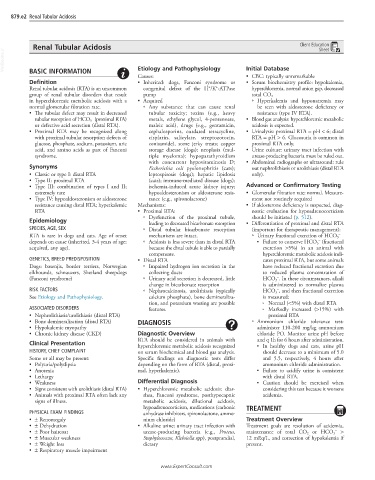Page 1750 - Cote clinical veterinary advisor dogs and cats 4th
P. 1750
879.e2 Renal Tubular Acidosis
Renal Tubular Acidosis Client Education
Sheet
VetBooks.ir Etiology and Pathophysiology Initial Database
BASIC INFORMATION
Causes: • CBC: typically unremarkable
Definition • Inherited: dogs, Fanconi syndrome or • Serum biochemistry profile: hypokalemia,
+
+
Renal tubular acidosis (RTA) is an uncommon congenital defect of the H /K -ATPase hyperchloremia, normal anion gap, decreased
group of renal tubular disorders that result pump total CO 2
in hyperchloremic metabolic acidosis with a • Acquired ○ Hyperkalemia and hyponatremia may
normal glomerular filtration rate. ○ Any substance that can cause renal be seen with aldosterone deficiency or
• The tubular defect may result in decreased tubular toxicity; toxins (e.g., heavy resistance (type IV RTA).
−
tubular resorption of HCO 3 (proximal RTA) metals, ethylene glycol, 4-pentenoate, • Blood gas analysis: hyperchloremic metabolic
or defective acid secretion (distal RTA). maleic acid), drugs (e.g., gentamicin, acidosis is expected.
• Proximal RTA may be recognized along cephalosporins, outdated tetracycline, • Urinalysis: proximal RTA = pH < 6; distal
with proximal tubular resorption defects of cisplatin, salicylate, streptozotocin, RTA = pH > 6. Glucosuria is common in
glucose, phosphate, sodium, potassium, uric zonisamide), some jerky treats; copper proximal RTA only.
acid, and amino acids as part of Fanconi storage disease (dogs); neoplasia (mul- • Urine culture: urinary tract infection with
syndrome. tiple myeloma); hypoparathyroidism urease-producing bacteria must be ruled out.
with concurrent hypovitaminosis D; • Abdominal radiographs or ultrasound: rule
Synonyms Escherichia coli pyelonephritis (cats); out nephrolithiasis or urolithiasis (distal RTA
• Classic or type I: distal RTA leptospirosis (dogs); hepatic lipidosis only).
• Type II: proximal RTA (cats); immune-mediated disease (dogs);
• Type III: combination of types I and II; ischemia-induced acute kidney injury; Advanced or Confirmatory Testing
extremely rare hypoaldosteronism or aldosterone resis- • Glomerular filtration rate: normal. Measure-
• Type IV: hypoaldosteronism or aldosterone tance (e.g., spironolactone) ment not routinely required
resistance causing distal RTA; hyperkalemic Mechanisms: • If aldosterone deficiency is suspected, diag-
RTA • Proximal RTA: nostic evaluation for hypoadrenocorticism
○ Dysfunction of the proximal tubule, should be initiated (p. 512).
Epidemiology leading to decreased bicarbonate resorption • Differentiation of proximal and distal RTA
SPECIES, AGE, SEX ○ Distal tubular bicarbonate resorption (important for therapeutic management):
RTA is rare in dogs and cats. Age of onset mechanisms are intact. ○ Urinary fractional excretion of HCO 3 −
−
depends on cause (inherited, 3-4 years of age; ○ Acidosis is less severe than in distal RTA ■ Failure to conserve HCO 3 (fractional
acquired, any age). because the distal tubule is able to partially excretion >5%) in an animal with
compensate. hyperchloremic metabolic acidosis indi-
GENETICS, BREED PREDISPOSITION • Distal RTA cates proximal RTA, but some animals
Dogs: basenjis, border terriers, Norwegian ○ Impaired hydrogen ion secretion in the have reduced fractional excretion due
elkhounds, schnauzers, Shetland sheepdogs collecting ducts to reduced plasma concentration of
−
(Fanconi syndrome) ○ Urinary acid secretion is decreased, little HCO 3 . In these circumstances, alkali
change in bicarbonate resorption is administered to normalize plasma
RISK FACTORS ○ Nephrocalcinosis, urolithiasis (typically HCO 3 , and then fractional excretion
−
See Etiology and Pathophysiology. calcium phosphate), bone demineraliza- is measured:
tion, and potassium wasting are possible ❏ Normal (<5%) with distal RTA
ASSOCIATED DISORDERS features. ❏ Markedly increased (>15%) with
• Nephrolithiasis/urolithiasis (distal RTA) proximal RTA
• Bone demineralization (distal RTA) DIAGNOSIS ○ Ammonium chloride tolerance test:
• Hypokalemic myopathy administer 110-200 mg/kg ammonium
• Chronic kidney disease (CKD) Diagnostic Overview chloride PO. Monitor urine pH before
RTA should be considered in animals with and q 1h for 6 hours after administration.
Clinical Presentation hyperchloremic metabolic acidosis recognized ■ In healthy dogs and cats, urine pH
HISTORY, CHIEF COMPLAINT on serum biochemical and blood gas analysis. should decrease to a minimum of 5.0
Some or all may be present: Specific findings on diagnostic tests differ and 5.5, respectively, 4 hours after
• Polyuria/polydipsia depending on the form of RTA (distal, proxi- ammonium chloride administration.
• Anorexia mal, hyperkalemic). ■ Failure to acidify urine is consistent
• Lethargy with distal RTA.
• Weakness Differential Diagnosis ■ Caution should be exercised when
• Signs consistent with urolithiasis (distal RTA) • Hyperchloremic metabolic acidosis: diar- considering this test because it worsens
• Animals with proximal RTA often lack any rhea, Fanconi syndrome, posthypocapnic acidemia.
signs of illness. metabolic acidosis, dilutional acidosis,
hypoadrenocorticism, medications (carbonic TREATMENT
PHYSICAL EXAM FINDINGS anhydrase inhibitors, spironolactone, ammo-
• ± Renomegaly nium chloride) Treatment Overview
• ± Dehydration • Alkaline urine: urinary tract infection with Treatment goals are resolution of acidemia,
−
• ± Poor haircoat urease-producing bacteria (e.g., Proteus, maintenance of total CO 2 or HCO 3 >
• ± Muscular weakness Staphylococcus, Klebsiella spp), postprandial, 12 mEq/L, and correction of hypokalemia if
• ± Weight loss dietary present.
• ± Respiratory muscle impairment
www.ExpertConsult.com

